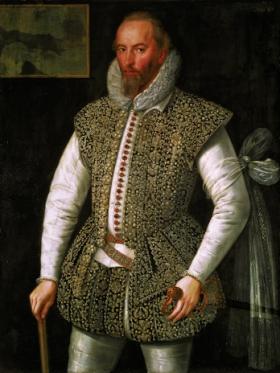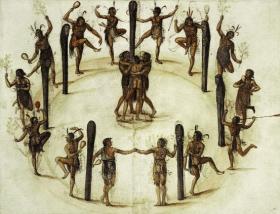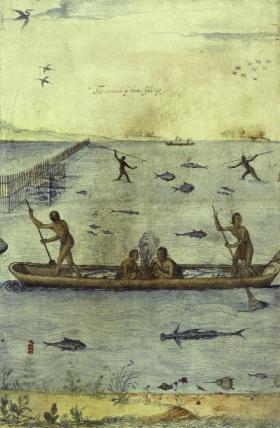1607 and all that: memory and Irish and American exceptionalism
Published in Early Modern History (1500–1700), Features, Gaelic Ireland, General, Issue 6 (Nov/Dec 2009), Volume 17
Sir Walter Raleigh—a prominent member of the Virginia Company—fought in Ireland, sponsored a settlement in Munster and tried to establish the first settlement in what he called Virginia, twenty years before Jamestown. (National Gallery of Ireland)
Anniversaries invite us to explore ‘who we are’. In fact, they usually tell us a great deal more about those who commemorate than about what is commemorated. The year 2007 was a case in point. The planting of Jamestown and the Flight of the Earls transformed America, Ireland and England. Each of these events is well known, especially so after the numerous commemorative events. Because of the debates that took place within each of these nations, a great deal can be deduced about the selective nature of memory. Certain aspects and occurrences are remembered or forgotten because of the ways we would have the world. Few, however, examine the meanings of one in conjunction with the other. Doing so allows us to ask not only how but also why Americans, Irish and English considered it so important to commemorate these events as they did. Indeed, the distinctive ways in which the Flight of the Earls and the settlement of Jamestown are remembered—or have to be remembered—in Ireland and America go to the heart of the ways men and women in each society tell the story of ‘what they are’.
The events of 1607 are known well enough. By 1609 a formal plantation policy initiated under King James I had been well established in Ireland. Under James, settlement would no longer be state-sanctioned but state-sponsored. As a postscript to the Nine Years’ War and by way of a prelude to plantation, the flight of the Gaelic Irish élites from Rathmullen, Co. Donegal, to the Continent in September 1607 marked, in the minds of historians, a dramatic shift in Irish history: the end of an old order and the birth of a new one. Gaelic Ireland would from this point struggle against English colonisation.
Jamestown: self-satisfied backslapping and righteous indignation
The same could be said for America. In May of that year, just over three months before the earls fled Ireland, about 100 men and boys from England landed on the banks of a small river which fed Chesapeake Bay, between the modern states of Maryland and Virginia. Christened Jamestown, the settlement represented the first permanent English settlement in what would become the United States. Initially, the settlers experienced tough times, as disease, starvation, harassment by the local Powhatans and threats from Spain conspired to push them to the edge of despair. With the arrival of reinforcements, the discovery of tobacco as a staple crop and the defeat of the local Indians in a series of wars, the Jamestown colony began to thrive. The year 1607, therefore, represented a watershed and, like Ireland, America would never be the same again.
Even 400 years later, the significance of these events is not forgotten in the United States. Predictably, self-satisfied backslapping and celebration characterised the commemorations, as well as condemnation and righteous indignation. Jamestown represents something essentially and quintessentially American—whether democracy and tolerance on the one hand, or racism and greed on the other. One group of descendants of the earliest settlers, fittingly called the ‘Jamestowne Society’ or the ‘Order of First Families of Virginia’, regard their forebears as the inventors of all that is right with America. ‘It was here on this sacred ground’, their governor declares, ‘that the principles of representative government, private ownership of land and civilian control of the military were firmly rooted in the New World.’ The Jamestown settlement also ushered in an enduring pattern of American history: the immigration story. The settlers blazed a trail for millions who would make their way from the Old World to the New. Others, however, counter that colonisation marks a very different moment, when America’s darker side was unleashed or made manifest on what would be the soil of the United States. Groups have organised counter-demonstrations on the anniversary of the first landing to ‘crash this illegitimate party and pursue the overdue case of reparations and justice for the victims of slavery, mass murder and genocide’. If the truth be told, this is the minority opinion. In 2007 most Americans embraced the view that 1607 marked the 400th anniversary of America’s birth. It was a year to be celebrated.
Flight of the Earls: tragic end of an old order

Opposite page: ‘A festive dance’, by John White. (British Museum)
Irish memory also reeled between such extremes. For most, the Flight of the Earls represented a tragic end to an older and perhaps simpler Ireland. The passing of the Gaelic order ushered in a prolonged period of complexity and uncertainty, of ethnic cleansing, suppression of language and culture, and the beginnings of a tragedy that would culminate in the Great Famine. Others have voiced ambivalence. In the wake of the scandals that have rocked the Catholic Church, along with the secularisation of Irish society, perhaps what occurred in 1607 did not matter a great deal. If Catholic, nationalist Ireland stood as the heir to the earls, maybe the nation was better off without them. Fintan O’Toole believed that the event did not represent a moment of finality, suggesting that most common people at the time fared just as well under the English. Although disrupted, Gaelic Ireland lived on and experienced a veritable renaissance after the Flight. Nor would the experience of plantation prove to be as awful as it would be remembered. As in the American case, most Irish tend to privilege one or another of these viewpoints. For most, 1607 represented a tragic moment in a history marked by conquest, and in 2007 they commemorated the event with scholarly conferences, re-enactments, concerts and museum exhibits.
Happenings in Ireland and America in 1607 are viewed as discrete events but they do intersect. English and Scottish plantation in Ireland served as both precedent and precursor to English settlement in North America. Conquest plans for Ireland, the language used to describe natives and even fort architecture were adapted for use in places like Virginia. A number of people were involved in both schemes. Prominent members of the Virginia Company also invested in Irish plantations, not least Sir Walter Raleigh, who fought in Ireland, sponsored a settlement in Munster and tried to establish the first settlement in what he called Virginia, twenty years before Jamestown.
White’s watercolours of Native Americans

‘The manner of their fishing’, by John White. (British Museum)
Raleigh was accompanied to America by John White. Little is known about White’s personal story, but he left a fascinating record of his American adventure. He produced some of the best-known images of Native Americans in the sixteenth or seventeenth centuries. In fact, they formed a key part of the British Museum’s exhibition in 2007 to mark the foundation of Jamestown. His watercolours compared North American Indians to the Celtic and Pictish peoples of the British Isles. Indians, he suggested, proved no more savage (nor indeed less savage) than the peoples who inhabited the peripheries of Britain and Ireland. Their clothes, weapons and body ornamentation bore striking similarities to those of their Gaelic counterparts. Above all, these people were not English; they spoke strange languages, had barbarous customs, superstitious religious beliefs and practices, and did not live according to civilised norms but dwelt in woods and fields. In short, they were not civil, at least by his standards. White’s Anglo-centrism does not shock or surprise but illustrates how he and his contemporaries saw the New World and its peoples in relation to the Irish.
White’s images also had important ramifications for the English in that watershed year as they shifted their attention from global to Atlantic endeavours.
Empires of trade gave way in inexorable fashion to empires of settlement; 1607 formed part of a broader pattern, and White’s images reflect this changing sensibility. They demonstrate that the English could and should settle Virginia—and, by extension, Ireland. Both places were inhabited not by civilised men and women, engaged in trade, but by savages or barbarians who should be ‘reduced unto civility’. Beneath English cultural standards, superstitiously papist or simply pagan, with pastoral economies or from hunter-gatherer societies, these people could be subdued and their lands cultivated. Such ideas could justify both the conquest of a people and the settlement of land. This ideology of civility lay at the heart of 1607.
White’s images also point to another uncomfortable truth about Ireland and America. In Ireland the natives did not die. The ‘Americans’ who celebrated 1607 400 years later did not, in fact, descend from those natives whom White had painted. The Indian society he portrayed in watercolour would be decimated by war and disease in the subsequent centuries. There would be no renaissance for those Indians whom the English encountered in 1607. Less than 100 years later, they would succumb to an ideology that had viewed their culture with contempt. In the United States, the anniversary of 1607 was celebrated by the descendants of the English, as well as by those who arrived in America much later but who accepted the outlines of the triumphal story: a white story for a white people. On the face of it, the Irish story of commemoration could not have been more different, as those who commemorated the Flight of the Earls in 2007 were, by and large, the descendants of those on the receiving end of settlement and conquest. Disease did not wipe out the indigenous Irish. Although an English ideology of civility consigned the Irish to a subservient role in society, they survived along with their culture and continued to outnumber their conquerors. The ‘Irish’, firmly identified with the vanquished, would struggle for hundreds of years and their national narrative would not die.
Two distinct yet similarly structured national narratives
What happened in Ireland and America after 1607, and how these events are remembered, is part of two distinct yet similarly structured national narratives. Americans see themselves as an exceptional people. A sense of American exceptionalism is echoed by memories of 1607. The Indians, by and large, serve as props to a triumphal story. They are not forgotten but they do not feature. Americans, those associated with settlement, see God’s hand in clearing the land and preparing the way for a more advanced culture. Those who followed also saw themselves as pioneers. Even if some Americans regard this tale with contempt, many would agree with the overall outline. America was and is exceptional, either blessedly or damnably so. The genius of American culture has been to incorporate other whites, even Irish Americans, within this tale.
The Irish also fancy themselves as distinctive, but in a very different way. They are, after all, the only white people to be colonised, or, at least, this is what they tell themselves. Theirs is a story of defeat, struggle and revival in which 1607 plays a pivotal role. In 2007 peoples from both nations may have been remembering mythic tales, but the manner in which they did speaks volumes about how they still view their societies today. HI
Patrick Griffin is Madden-Hennebry Professor of History at the University of Notre Dame.
















